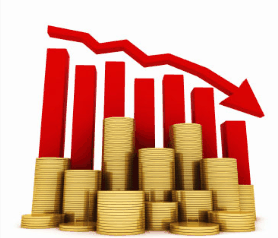
As noted by Houses & Holes earlier today, the Commonwealth Budget Update, released on Friday, revealed a $6 billion hole in the Government’s revenue forecasts, which has led to an underlying budget deficit of over $18 billion.
In his explanation of the figures, Treasurer Wayne Swan noted the following:
We’ve seen our terms of trade – the price we receive for exports compared to the price we pay for our imports – fall in large part because of declines in commodity prices. Historically, a decline in our terms of trade has been accompanied by a fall in the dollar which has provided support for the economy and revenues, but this time the currency has stayed persistently high. This has contributed to subdued prices pressures and weaker profitability across the economy, which means that nominal GDP – the value of the goods and services we produce – has grown more slowly than real GDP for three straight quarters. This run is unprecedented since records began.
Over the weekend, Fairfax’s Ross Gittins wrote an excellent primer on the link between the growth of nominal GDP and budget revenues:
… the growth in nominal GDP is the best guide to the growth in tax revenue… it’s the main reason why, despite all his [Swan’s] savings measures (and creative accounting), the government won’t be able to keep the promise it made in the 2010 election campaign to get the budget back to surplus this financial year…
We’re used to assuming that, if the economy’s growing in real terms (which it has been), the government’s tax revenue will be growing at least as fast and probably faster. (Why faster? Because almost half the feds’ tax collections come from personal income tax, which grows extra strongly because, in the absence of the indexation of tax brackets, it’s subject to ”bracket creep”).
…nominal GDP should be growing at a reasonably steady 2.5 percentage points or so faster than real GDP. But we learnt from last week’s national accounts for the December quarter that, for the first time on record, the past three consecutive quarters have seen nominal grow by less than real, not more. Since real GDP grew by 1.9 per cent, nominal GDP should have grown by about 4 per cent. Instead it grew by a pathetic 1.6 per cent…
The difference between nominal and real GDP is measured not by the CPI but by the ”implicit price deflator” for GDP. When the economy’s travelling normally, there shouldn’t be much difference between the GDP deflator and the CPI and other measures of the change in the price of domestic spending.
But ”normal” means when our terms of trade aren’t changing much. When they’re improving or deteriorating sharply, the GDP deflator and measures of domestic-spending inflation really part company.
Why? Because domestic spending includes the prices of imports but excludes the prices of exports, whereas GDP and its deflator exclude the prices of imports but include the prices of exports.
It works out that nominal GDP will grow very much faster than real GDP when our terms of trade are improving sharply, but nominal may even grow more slowly than real when our terms of trade are deteriorating sharply – as they were last year.
…Treasury (and everyone else) was expecting any deterioration in the terms of trade to be accompanied by a similar fall in the exchange rate.
To everyone’s surprise, the dollar has stayed up. This means the prices of imports haven’t risen in the way you’d have expected, causing domestic inflation to be lower than expected. This, in turn, has meant nominal incomes haven’t risen as fast as could have been expected…
The strongest relationship [to nominal GDP] is with taxes on profits – company tax, income tax on unincorporated businesses and the two resource rent taxes. These account for about a third of total tax revenue.
The below charts visually explain what Gittins is referring to. First, the implicit price deflator – the measure of inflation used for determining the difference between nominal and real GDP – has been negative for four of the past five quarters:
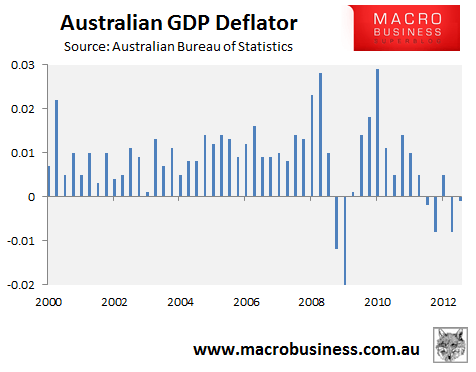
This is an unusual event, which has only occured on a handful of occasions over the past 50 years:
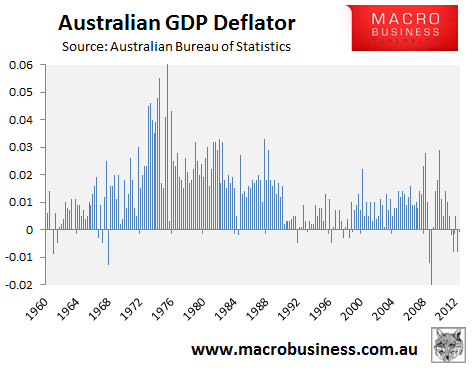
As explained by Gittins, the key reason for the decline in the implicit price deflator is the slump in the terms-of-trade, which has declined sharply over the past five quarters:
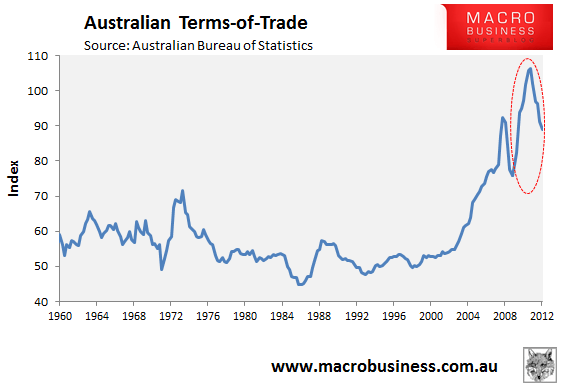
The net result is the unusual situation where nominal GDP is growing less strongly than real GDP:
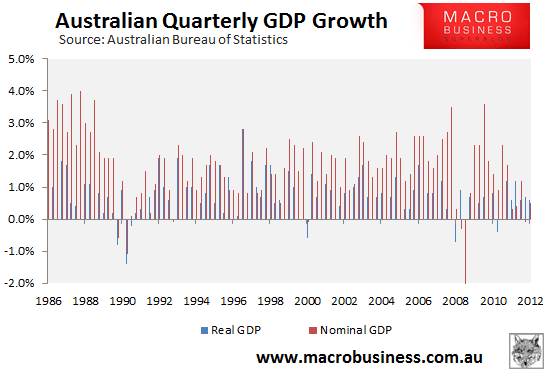
The implication is that budget revenues will remain under pressure as long as the commodity price boom unwinds and the terms-of-trade retraces. The implications for national incomes are similar. As long as the terms-of-trade are falling, per capita national disposable incomes will grow less strongly than per capita real GDP, unwinding much of the income gains achieved since 2003 on the back of the commodity price boom (see below charts).
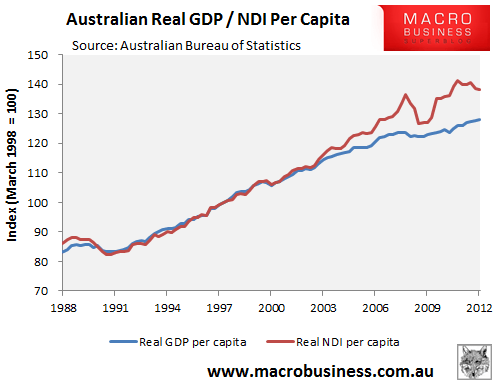
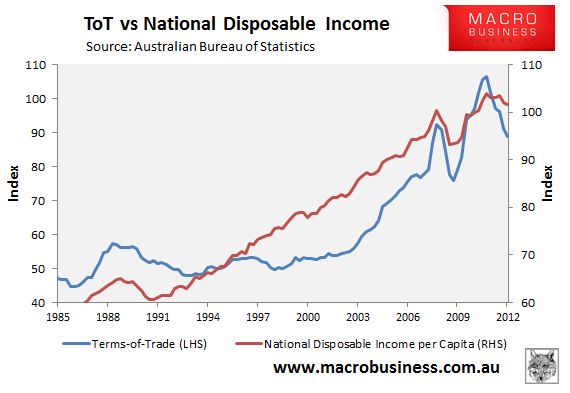
Welcome to the dark side of the boom.

